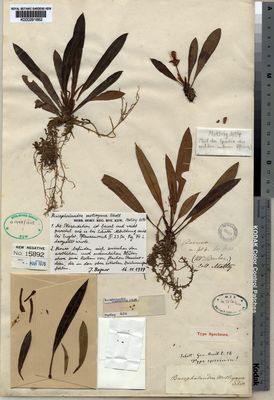Small herb 5-20 cm tall. Stem more or less condensed, creeping to suberect, 3-10 cm long, 0.4-0.8 cm diam. Leaves to c. 10 together; petiole (0.5-)1-8 cm long, 2-2.5 mm diam., adaxially canaliculate, reddish, sheathing at the extreme base, the wings extended into a very narrowly triangular ligular portion to 3 cm long, drying dark reddish brown; blade obovate to elliptic to very narrowly oblanceolate, rarely sublinear, (0.7-) 5-7(-10) cm long × (0.3-)2-2.8 cm wide, more or less coriaceous, glossy dark green adaxially, paler abaxially and sometimes tinged reddish, finely punctate on both surfaces, the base cuneate, the apex acute to rounded and apiculate for 1-2.5 mm, the margin somewhat revolute (very narrow forms) to somewhat undulate (broader leaved forms); midrib abaxially and adaxially prominent, reddish abaxially, with (1-)3-4 primary lateral veins on each side (absent in very narrow form), diverging at 25-60° and running to a marginal vein; secondary venation adaxially more or less obscure, abaxially fine and not dense (c. 1-1.5 mm apart); tertiary venation adaxially obscure, abaxially forming a faint tessellate reticulum. Inflorescence solitary, very rarely in a small synflorescence in robust specimens; peduncle exceeding the petioles, 2-13 cm long, reddish. Spathe broadly ovate, not constricted, (0.7-)2-3 cm long, the lower part funnel-shaped, green, persistent, the limb gaping, white, caducous, apiculate for 2-3 mm. Spadix (0.5-)1.2-2.5 cm long; female zone (0.1-)0.3-0.5 cm long, (0.15-)0.3-0.5 cm diam., 2-5 whorls of pistils; pistils ovoid to depressed globular, 0.6-1 mm diam.; stigma sessile, discoid, about half the diameter of the ovary, somewhat impressed centrally; interpistillar staminodes absent from among the pistils, absent or 1-a few at the base of the female zone, very small, c. 0.25 mm diam., subsessile; interstice consisting of 1-2 whorls of scale-like staminodes 1-2 mm long × 0.8-1.5 mm wide, at first erect then spreading; male zone 0.2-0.4 cm long, 0.1-0.3 cm diam., consisting of 2-5 irregular whorls of stamens; stamens large, to 1 mm across, truncate, with at first inflated then flatter thecae on the proximal (with respect to the spadix axis) side of the stamen; thecae with at first upward- then outward-pointing (with respect to the spadix) horns 0.2-0.3 mm long each with a minute pore at the tip; appendix globular to ellipsoid, 0.2-1 cm long, 0.2-0.5 cm diam., yellow; staminodes of appendix obpyramidal to subcylindric, truncate, sometimes partially connate especially in the distal part of the appendix, 0.5-1 mm diam., papillose on the upper surface. Fruiting spathe funnel-shaped, 0.5-1.2 cm diam.; berry depressed-globular to ellipsoid-oblong, 1-1.8 mm long, 1-1.5 mm diam., with numerous seeds; seed narrowly ellipsoid, 1-2 mm long, 0.25-0.3 mm diam., light brown, very slightly longitudinally ribbed to scabrid, with a curved micropylar appendage to 1 mm long.
Schott’s original description (Schott 1858) is scanty and contains serious errors (see Bogner 1980 for discussion). Subsequent descriptions (Bogner 1980; Bogner & Hay 2000) are compiled from numerous different species, in line with then taxonomic concepts, and are therefore not reliable for envisaging Bucephalandra motleyana. Recollection of B. motleyana at the type locality is required, but see below.



